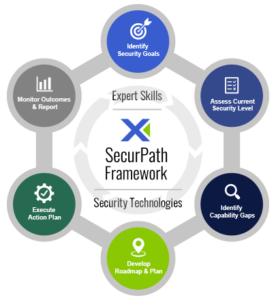

By Amos Aesoph, Xigent CISO
Information security improvements have been trending amongst organizations wanting to combat the rise in cyberattacks. According to InfoTech, 75% of cybersecurity experts say the current cyber threat landscape is “the most challenging within the last five years.”
In the final episode of “Tips to Avoid IT Security Pitfalls,” Xigent’s Chief Information Security Officer, Amos Aesoph, shows SecurPath’s security improvement methodology for enhancing your organization’s information security.
Information security (InfoSec) refers to the practice of protecting sensitive digital information from unauthorized access, modification, or distribution. Organizations typically implement various strategies to improve their information security fundamentals.

Enhancing your information security isn’t about hiring a qualified security program leader alone. You start by creating a structured methodology to understand your current security status, then put measures in place to achieve your security goals for the future.
Take SecurPath’s security improvement methodology, for example. By replicating these six steps, you will have a starting point for achieving a security methodology you can be confident in for years to come.
Establishing and measuring security goals within an organization involves a systematic approach to protect valuable assets and sensitive information. Struggling to establish your security goals? Try the steps below:
Once security goals are established, it’s time to measure them with key performance indicators (KPIs) to ensure they are as productive as possible. Common security KPIs include:
Properly securing your organization means identifying and improving your weakest areas. Below are specific tests and assessments organizations should implement to help uncover gaps and vulnerabilities. These include:
We highly recommend every organization perform these tests regularly to identify weaknesses in systems, applications, data storage, employee security awareness, and more.
Improving your organization’s information security in 2024 takes time and effort and requires a structured methodology with clear, quantifiable security goals. By adopting Xigent’s SecurPath, you have access to an entire team of experts who leverage SecurPath’s security improvement methodology for you.
CLICK HERE to connect with a SecurPath Expert and start your journey towards improving your organization’s information security.
Be sure to check out Xigent’s SecurPath web pages, follow us on social media, and stay up to date on IT Security topics:
Xigent’s Tips to Avoid IT Security Pitfalls
Part 1 – Common IT Business Risks
Part 2 – What Drives the Need for Improved Security?
Part 3 – How Secure Does My Organization Need to Be?
Part 4 – How Do I Measure Security Effectiveness?
Part 5 – How Do I Improve My Information Security?

Amos Aesoph serves as Xigent’s Chief Information Security Officer. With 20+ years of broad-based IT leadership experience, Amos has created new departments, technologies, and systems. Amos leads Xigent’s Security Services and advises clients on security trends and best practices, enabling policies, procedures, and technologies to minimize vulnerabilities and business risks. Over the years, Amos has been featured on various panels and presentations and, most recently, an “In the Moment” segment on South Dakota Public Radio.